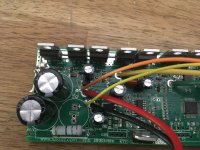Does anyone know how an LCD8H tells a KT controller to turn on the headlight circuit?
Here's the issue I'm trying to solve - I'd like to be able to turn the headlight off and on using the display (hold the up button until the headlight icon appears). On the probably more common LCD3 display holding the up button turns on the display backlight and the light circuit.
After burning up my previous controller I got a new, larger one that has the headlight connection. The problem is that unfreakingbelievably, the headlight circuit does not turn off and on using the display. It in fact does not turn off at all, ever. This has been verified by the seller, Chamrider, it's just on all the time which boggles my mind.
I recently installed head / tail and brake lights on another bike with a KT controller, and this is wired the exact same way using a step down transformer and relay.
Now I'm trying to figure out how the display tells a controller to turn on the light, if that controller has a switching light circuit. I've checked voltages at the 5 pin display connector with the light both on and off, and voltages are the same either way. Red and blue are battery voltage, and yellow and green are 4.5v. If I could find a difference I could use that as a signal to control the relay. Any ideas?
Here's the issue I'm trying to solve - I'd like to be able to turn the headlight off and on using the display (hold the up button until the headlight icon appears). On the probably more common LCD3 display holding the up button turns on the display backlight and the light circuit.
After burning up my previous controller I got a new, larger one that has the headlight connection. The problem is that unfreakingbelievably, the headlight circuit does not turn off and on using the display. It in fact does not turn off at all, ever. This has been verified by the seller, Chamrider, it's just on all the time which boggles my mind.
I recently installed head / tail and brake lights on another bike with a KT controller, and this is wired the exact same way using a step down transformer and relay.
Now I'm trying to figure out how the display tells a controller to turn on the light, if that controller has a switching light circuit. I've checked voltages at the 5 pin display connector with the light both on and off, and voltages are the same either way. Red and blue are battery voltage, and yellow and green are 4.5v. If I could find a difference I could use that as a signal to control the relay. Any ideas?


